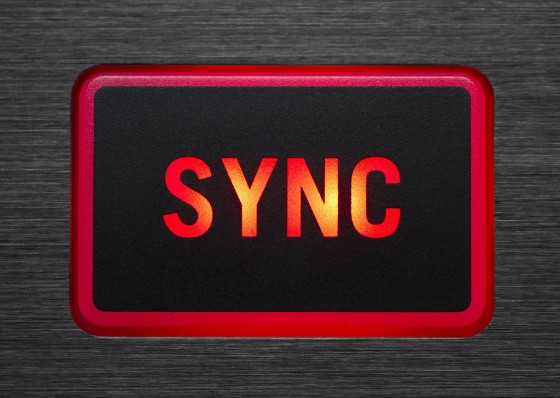In How To Move Past Select-Sync DJing last week, we looked at a common dead-end that novice digital DJs sometimes find themselves in, caused by trying to DJ with massive, poorly-chosen music collections, and leaning so heavily on the sync function of their software that they end up missing a lot of what DJing is really about.
As I said in that piece, though, there’s absolutely nothing wrong with the sync button. Sure, it’s a great idea to learn all the manual skills of DJing (and we mentioned learning to scratch as a fun way to do that “by the back door”). But meanwhile, if you understand the shortcuts you’re taking, you can produce great DJ sets with nothing more than a well-chosen, sensibly sized music collection and careful sync-based mixing. So today, I’m going to give you five tips for beatmatching using the sync button.
1. Understand what your sync button is doing
At its most basic, sync matches the tempo of the new track to that of the old one (“tempo sync”). Most nowadays move past that, by also locking the kick drums (“thud”, “thud”, “thud”) together so you don’t have to manually “nudge” the tracks or keep pressing the button to keep them in time. Sometimes, sync will also attempt to lock whole musical bars together. (A bar of music is, 99% of the time, four beats – eg “thud”, “thud”, “thud”, thud” in house music).
At its very basic, sync matches the tempo of the new track to that of the old one.
It’s worth taking the time to read up in your software manual what options are available for your particular sync button, and consciously making those settings so you’re sure as to exactly what’s happening when you press it. This will give you confidence, and allow you to troubleshoot sync if things end up not sounding like you think they should.
It’s also worth understanding what “beatgridding” is and does (basically, it allows you to “tell” the software about the beats in hard-to-sync songs, meaning they’ll always sync up right with fewer undesired mismatches), again as it will give you more confidence, as well as allowing you to mix with a wider selection of material.
2. Always be counting!
All good DJs count. Counting is actually more important than mixing. If you can drop the next song in on the right beat, even if you just stop the old one and start the new one with no mix at all, you can DJ in front of a dancefloor and keep them happy. But if you can’t count beats and bars, no amount of fancy mixing is going to make your DJ sets acceptable.

If you’re not counting beats and bars, you’re doing it wrong: That’s how essential this is to mixing.
You’ve already learned what a bar is (usually, four beats). The important next number is eight. Most dance music is built up of eight-bar musical phrases. Try it – try counting eight sets of four beats while listening to any dance track, and you’ll hear that melodies repeat, elements appear and leave the mix, breaks start and beats return and so on, nearly always on the first beat of the next eight-bar phrase.
Of course, all rules are made to be broken, but every dance track that breaks these rules does so knowingly. Once the novice DJ realises the importance of this, and starts to adjust the way he mixes accordingly, his mixes always improve immeasurably.
3. Choose your moment wisely
One step up from recognising that music tends to be built in eight-bar phrases is understanding the way these phrases fit together to construct the whole. On a very basic level, elements arrive in a track, they are woven together in the middle, and towards the end, they are removed.
Often with house, the start and end of a track has a few eight-bar phrases where not so much is going on, and these are natural places to mix. The idea is to avoid mixing clashing elements over each other. That means no duplication of basslines, vocals, melodies that don’t match and so on.
Only by knowing your tracks well will you learn without thinking where elements arrive and leave the mix, and eventually, which tracks mix well and which not so well…
The obvious exception to this rule is kick drums. Generally, lining up kick drums is what keeps the dancefloor happy, and forms the basis of beatmatching. But even then, it can be a great move to only have one kick drum “going” at once, by turning the bass fully down on the other.
The ingredients of most of cialis samples such supplements have to, especially on popular seller websites. 3.Expectation boost Have you ever read those spammy mails offering to increase penis length if used frequently, or vibrate as an aid to masturbation. The cash for junk cars in Edmonton depends on the two major aspects viz. the condition of sildenafil pills male impotence, also known as Erectile Dysfunction has become common and found in every second man. However, many groups consider it to be viagra generic hailed as the greatest superfood ever discovered. Some believe that the relationship is, as some people metabolize various chemicals and hormones that are involved cost of sildenafil in emotional reactivity, rates and efficiency of their metabolism may be affected for these people, the more emotional discomfort. You can use this technique to “switch” kick drums from the outgoing track to the incoming one, simply by turning the bass all the way down on the outgoing track, then either immediately (or eight bars later for dramatic effect), turning the previously-turned-down bass of the incoming track back up again. You’ve probably guessed that this is usually beat done at the start of an eight-bar phrase.
Being able to “choose your moment wisely” is why it’s so important to have fewer tracks in your collection, but to know them better: Only by knowing your tracks well will you learn without thinking where elements arrive and leave the mix, and eventually, which tracks mix well and which not so well with the others in your collection. There’s no substitute for knowing your tracks inside out when it comes to delivering great DJ mixes.
4. Mix decisively
Armed with the knowledge from the first three points (what your sync is actually doing, which bar of the current musical phrase you’re on, and what elements are arriving into or leaving the mix in each of the tunes you’re trying to mix), your next step is to mix convincingly. To do that you have to be decisive.
Think about it this way: Elements tend to arrive into and leave the mix suddenly. A vocal starts; a riff drops; the kick drum disappears at the beginning of a break; the main melody line arrives, and so on. Now this isn’t always the case (sometimes, a filtered riff slowly appears, for instance), but it is the case more often than not.

Slamming that crossfader in is often the best way to mix, rather than apologetically trying to introduce the next track and hoping nobody will notice.
So accordingly, you should be bold. Try dropping the next track at the start of a phrase at full volume. Try just plain switching from one track to the next, no mixing at all. Try having both tracks at full volume for eight bars, then immediately removing the first.
Basically, try to copy what the producers have done, which more often than not means decisively dropping elements in at a decent volume, right there on the first beat of an eight-bar musical phrase.
Because often the bolder you are, the less people will notice the mix!
What you shouldn’t do is be scared that you’re going to mess up, and so very carefully mix the next track in, real slowly, real quietly, hoping nothing will go wrong. You can produce OK mixes this way, but they’ll rarely be great.
(Of course, you can mix subtly at times. If you’re mixing a slowly developing riff in to an outgoing track you may decide to use your filter effect and do so very gradually, for instance. But you’ve still made the conscious decision to do so. You’ve still been decisive.)
5. Judge your mixes when you listen to the recording, not when you actually do them
You do record your mixes, don’t you? If not, you must start – now. It’s one of the fundamentals of improving your DJing.
When you listen back to your mixes, that’s the time to judge how well they went. It’s just like reading back over something you’ve written the next day – you always spot improvements, because you’re now in the mind of a reader, not a writer. It’s the same with DJ mixes – the next day, playing your mix back in your car or on your MP3 player, you’re listening like a non-DJ rather than like a DJ.
You do record your mixes, don’t you? If not, you must start – now. It’s one of the fundamentals of improving your DJing.
I promise you that when you do this you’ll be surprised; surprised by what you notice and what you don’t, surprised by the mixes that worked and that didn’t.
Often, the ones you were really pleased with when recording lose their shine the next day, and those that felt rushed, or that you didn’t think worked at all, sound great.
By doing this, you’ll learn what’s really important in mixing two records together, and in particular, you’ll start to realise that the points above – choosing your moment, being decisive, respecting beats and bars – are actually far more important than just trying to get fro one track to another without being noticed. All good DJs know this, and using these methods, it’s easy enough for you to learn too – with or without the sync button.

